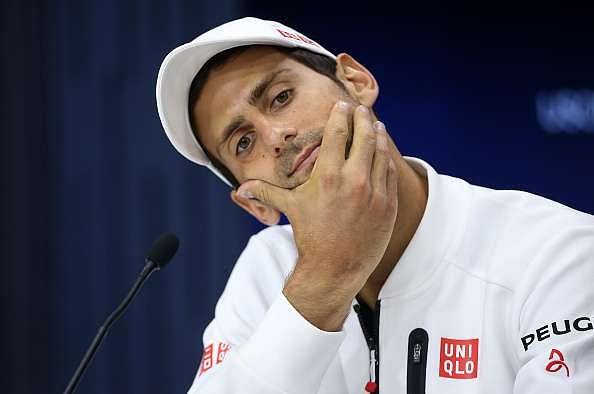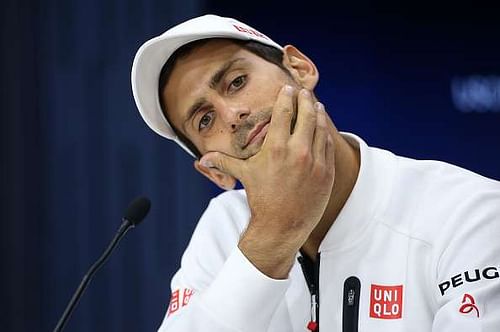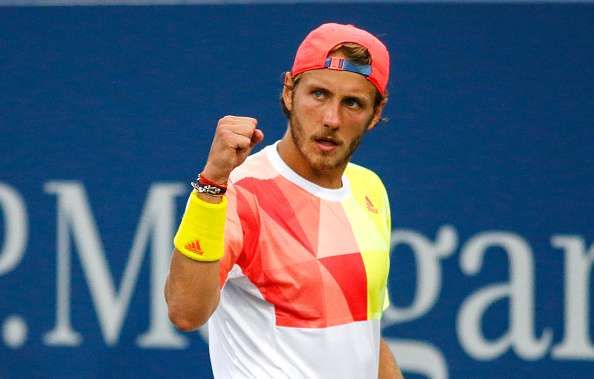
US Open diary: Keys brings the house down, and nobody can decide whether Djokovic is lucky or cursed

Novak Djokovic at his press conference
An early afternoon match at any Slam usually means low stakes and crowd numbers that can’t possibly be described as overflowing. Does that change when one of the players involved is a national star? A little, yes – as I found out yesterday while watching Madison Keys trying to quell the challenge of the supremely talented teenager Naomi Osaka.
There was sizeable support for Keys, and also more than a passing interest in the Japanese youngster. The latter unleashed a series of world-class groundstrokes all through the match to make everyone sit up and take notice of her; even though she’s just 18, it was tough for anyone to spot a weakness in her game.
But the American didn’t really need a packed stadium or a high-quality opponent to produce a memorable performance; the highs and lows that her playing style lends itself to are so extreme, that there’s literally never a dull moment when you watch her play. And boy were there plenty of highs and lows yesterday.
I didn’t get a great seat for the match because of the presence of the substantial Japanese media contingent, and so had to be content with watching the play from one of the promenade seats. That didn’t really dull the sound or impact of the two women’s shots though; Keys in particular hits the ball violently enough for you to start fearing that her arm will fall off any minute.
It was a stirring comeback from the American in the face of some excellent play by her opponent, but you could see that Osaka’s inexperience played a part in the result. Keys admitted as much in her press conference, saying that she just tried to hang in there and wait for her opponent’s errors. For the crowd though, by the end of the match it was almost like Keys was the only player on the court. Every nervy error by Osaka was greeted with thunderous applause, while every mistake by Keys was met with exasperated groans.
Soon enough, Keys took her cue and started unloading on the big groundstrokes again. After spending much of the second and third sets struggling to find the broad side of a barn with her forehand, she finished with a string of big shots that reminded us why she is considered to be the hardest-hitting female player in the world today. But the moment it was all over, she went back to her diminutive self, sounding like a shy teenager in both her on-court interview and post-match presser.
It’s hard to comprehend how a player as aggressive and powerful on the court as Keys can be so soft-spoken and demure off it. You have to really strain your ears to hear her speak, and she doesn’t seem capable of uttering a single nasty word about anyone. But that’s tennis for you, I suppose – glorious contrasts wherever you look.
Unfortunately for us in Arthur Ashe stadium though, there wasn’t a lot of tennis that immediately followed the Keys-Osaka epic. Novak Djokovic looked in fine form for the six games that he was on court, before Mikhail Youzhny’s withdrawal while trailing 2-4 put a dampener on everyone’s spirits. Djokovic tried to make up for the disappointment a little by having an impromptu practice session right after the match, but everyone was more interested in analyzing what this second successive walkover would mean for the Serb’s title chances.
There were furious debates in more than one section of the stands, even as we watched Djokovic display his patented athleticism during his hitting session. “He’s so lucky, he’s not had to spend any energy at all!” was countered by “You need some rhythm in the first week man, he can’t be happy about this.” “What a great way for him to get his wrist healed completely,” went one guy looking at the glass half-full, while the cynic in his group responded with “I’d like to see him take on John Isner’s serve with so little match practice.”
Djokovic himself seemed to think this was a good thing on balance. “Considering the stage of the season, you know, the amount of matches I've played, what I've been through with my body, I think it's actually good to have some days off and then shorter matches from one side. Sure, as you are approaching second week of the Grand Slam you want to have match play and you want to have time spent on the center court before you face one of the top players. But I'm not too concerned about my game itself. I've worked hard the last couple days. Health-wise I feel much better than I did at the beginning of the tournament. You know, I'm confident that everything is going in the right direction.”
So there you have it – while the rest of us may not be able to decide whether Djokovic is outrageously lucky or the most unfortunate player in Flushing Meadows, the man himself has a crystal clear picture in his head. Maybe that’s why he’s World No. 1 and we are not.
The abrupt end to the Djokovic match meant I had some time to kill before the start of the evening session, so I strolled over to Court 17 where Roberto Bautista Agut was doing battle with Lucas Pouille. And I’ll say it right off the bat – Court 17 is by far the best court in the entire arena.

Lucas Pouille
It’s big enough to be a show court, but not big enough to have stuffy designated seating positions. So anyone can just walk in and choose a seat of his or her preference, and if you’re lucky enough, you’ll get a seat just a few feet from the players. It’s also sufficiently airy and cool to not let the sun affect you too much, and the atmosphere can be quite electric with the right kind of match.
Pouille vs Bautista Agut was certainly the right kind of match. While neither of them is a high-profile star, they are both bona fide Top 20 players and so can produce some high quality tennis of their own. Pouille had a greater share of the crowd support, probably because of his more attractive shot-making capabilities, but there was plenty of appreciation for Bautista Agut’s rock-solid baseline play too.
As I watched the match unfold from my near-perfect seat (I heard one guy in my row say to his friend, “This is heaven on earth man; there’s no other place I’d rather be”), I could only marvel at the incredible spin and speed with which both of them were hitting the ball. Both of them are forehand-dominant players, and their groundstroke of choice was appropriately impressive, but even their backhands looked spectacular from our vantage point. In almost every rally it seemed like one of them wouldn’t have the time to get the ball back over the net, but they were both so quick with their feet that the ball not only got over the net, but somehow found its way to an impossible corner of the court – and that too at a million miles an hour.
After the fourth set I left the court to head for Arthur Ashe (where Rafael Nadal was about to start playing), but I probably shouldn’t have. Pouille would go on to complete his comeback and clinch the fifth set 6-1, and I can only imagine the high-octane note the match would have finished on.
It’s not just the Federers, Nadals and Djokovics of this world that can put on a breathtaking show of tennis. Thank God we have a court like No. 17 to remind us of that.